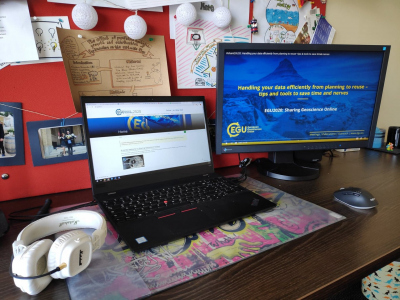Peter Kiss
Report of GLOMAR PhD student Peter Kiss about his participation in the European Geosciences Union General Assembly (EGU) 2020 - online from 4 to 8 May 2020
Ever since 2004, the European Geosciences Union (EGU) has been yearly convened a multi-day General Assembly for geoscientists with various research interests in order to encourage them for presenting their novel results, establishing international collaborations and developing new research ideas. The annual EGU General Assembly has been taken place in the capital city of Austria, in Vienna, since 2005. However, this year required huge creativity by the organising committee, since the entire conference had to move in only 6 weeks to the online platform due to COVID-19 outbreak. Despite the challenging situation, the organizers bravely faced the global crises and introduced a new format of online conferences, which could present an exemplary approach for other scientific retreats held during the time of pandemic. Probably nothing proves the success of this year´s General Assembly better than the thousands of delighted attendees, for whom the organizers confirmed that scientific meetings can be fruitful, even online, under the control of a flexible committee with innovative ideas.
The subjected assembly has displayed year after year increasing interest among researchers. For example, in 2018 the assembly hosted more than 15.000 scientists from 106 countries, while in 2019 the number of participants rose over 16.000, who came to Vienna from 113 countries with the aim of presenting 5.531 oral presentations and 9.432 posters. The tendency of growing interest continued this year as well. But the scientists were replaced by individual online users, oral and poster presentations by online chats in chat-rooms, evening gatherings by meetings via software Zoom and online game nights, scientific discussions and courses by videos uploaded on the EGU YouTube channel, which could be followed by curious attendees from home. Yes, this year we are talking about curious participants instead of scientists, because the General Assembly was freely available and followable for everyone. With this initiation, the EGU intended to illustrate that scientific world is opened for public and they want to gain back the trust of people working outside of academia in recently emerged difficult times, when more and more people are losing their faith in science. Such an exemplary attitude brought spectacular results. The 2020 General Assembly was visited by 26.219 individual online users, who joined 721 live chats. In overall, during the course of the conference, users exchanged 200.400 messages and wrote 6.297 comments.
This year´s programme, like previous years, yielded fascinating and diverse contributions by the individual authors. The programme schedule encompassed from planetary research through glaciology and palaeoceanography to public outreach various fields of geosciences. My presentation about the Determinants of calcite flux in planktonic foraminifera on seasonal and interannual time scale was assigned to session Atmospheric Acidity, Air-seas Chemical Fluxes and their Impacts. Prior to the presentations, each author was asked to upload their contribution to their “display” available on the EGU official website, where any topic-interested person could download the presentation or leave a comment for the author. Afterwards, the presentation was held in form of live chats in chat-rooms, which took approximately 10 minutes. My session’s chat room was attended by 65 online users, which means that from the overall 25 presenters, there was a considerable number of followers who joined the chat communication. Unfortunately, the session I intended to attend, was merged with other sessions involving atmospheric studies and these contributions accounted for approximately 90 % of the entire session. Thus, most of the chat attendees were not specialized on oceanic chemical fluxes and I felt as an outsider. Due to the high number of contributions (including several key lectures) and the limited time (2 hours), the conveners made a drastic decision to cut my time availability for two minutes. The course of two minutes, I gave a short summary about the main outcomes of my research and I left all of my contact details in the chat room for further discussion and possible collaborations. After the session, I was approached by some chat users via e-mails, who were mainly interested about the efficiency of the chosen methodological approaches used in my study. All in all, I think this was a very peculiar way of sharing my results, which could have been more beneficial for me and for the joined spectators only in case of longer time scope.
Attending an online conference surely don’t replace international meetings, which we visit in classical way. Besides the aforementioned advantages there are plenty of disadvantages. Even though communication in the XXI. century is supported by many technical innovations, meeting with someone personally and exchanging our ideas still remain preferable during coffee breaks. On the other hand, we should keep in mind that thousands of attendees should travel and stay in Vienna, which increases the emission of harmful gases damaging Earth´s ecosystems. This was successfully avoided by organising the conference online and thus we should remember it in a positive way with a motto of “cutting carbon in the geosciences”.



